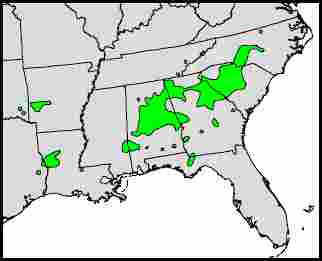Chalk Maple
(Acer leucoderme)
The Chalk Maple is a small deciduous tree native to the southeastern and south-central United States. It gets its name from the smooth chalky-white bark of mature trees. Another common name is Whitebark Maple, but the color actually varies, and is usually closer to light gray than clean white.
The tree typically grows 20-30 feet tall and is often multi-trunked. In many ways it is a smaller version of the widely-planted Sugar Maple (Acer saccharum), and in fact is sometimes classified as a subspecies of that plant. For someone who wants similar brilliant fall foliage, but doesn't have much space, the Chalk Maple is an excellent alternative. Its fall color, ranging from yellow-orange to deep red, is always spectacular.
This tree is generally easy to grow. It isn't choosy about soil, and established plants can tolerate heat and drought. Cultivated specimens have also proven to be fully cold hardy in Zone 5, well north of the native range.
Chalk Maple is sometimes confused with the more common Southern Sugar Maple (Acer barbatum), also called Florida Maple. The two species are similar, but the Chalk Maple is a more upland tree, and it typically has better fall color. Other small maples native to the eastern United States include the more northern Striped Maple (Acer pensylvanicum) and the Mountain Maple (Acer spicatum).
Maple seeds are eaten by Grosbeaks, Nuthatches, Finches, Porcupine, Squirrels, Chipmunks, Deer, and other wildlife.
Other Information
Scientific Names: Acer leucoderme, Acer saccharum ssp leucoderme
Common Names: Chalk Maple, Whitebark Maple
Plant Type: Small deciduous tree
Height: 20-40 feet
Cultivation Zones: 5 - 9
Native Habitat: Understory of upland forests
Native Range: Mostly southeastern United States, with scattered populations in Arkansas, Oklahoma, Louisiana, and Texas. See distribution map below.
Distribution Map

Range Map Source: U.S. Forest Service. (See General Note C)
Conservation Status: NatureServe lists Acer leucoderme as Imperiled or Vulnerable in Arkansas and Louisiana, Vulnerable in Tennessee, and possibly Vulnerable in North Carolina. Officially the species is listed as of Special Concern by the state of Tennessee.
Cultivation: Chalk Maple can tolerate shade and adverse conditions, but will grow faster and have better form in good soil and a sunny location. Do not over fertilize. Go to Cultivation for more information.
Plant Sources: Possible suppliers of Chalk Maple include Woodlanders, Nearly Native Nursery, and Forest Farm. For links, go to Sources of Plants.
Photos
|

